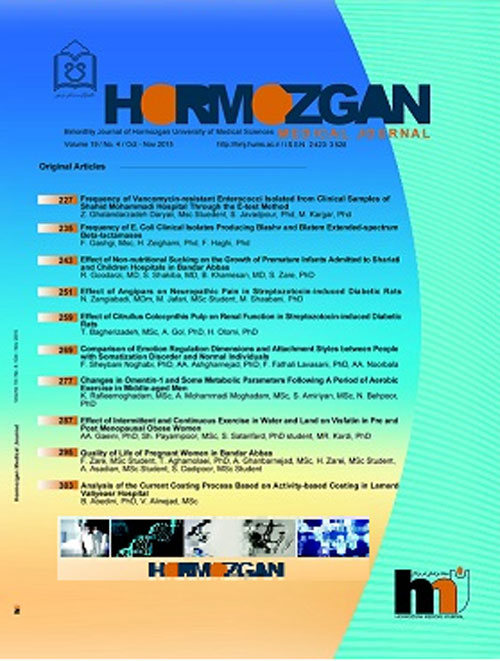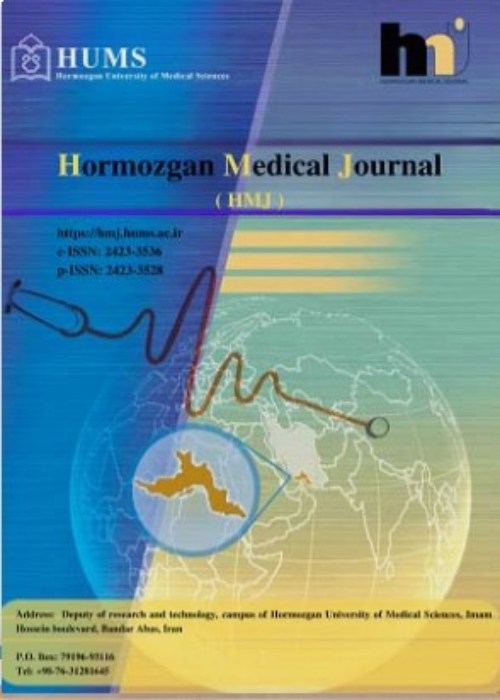فهرست مطالب

Hormozgan Medical Journal
Volume:20 Issue: 3, Aug-Sep 2016
- تاریخ انتشار: 1395/06/22
- تعداد عناوین: 9
-
-
صفحات 235-243
-
Pages 169-175IntroductionIron deficiency anemia and beta-thalassemia trait are the two most common causes of hypochromic microcytic anemia. There are some discriminating functions (DFs) formula to differentiate these two conditions based on RBC's indices which would be compared the validity of the 14 various indices in this study.MethodsA total of 227 patients from 21st March to 21st June 2014 were studied by calculating 14 DFs i.e. Keikhaei (KI), RDWI, Green & King (G & KI), England & Fraser (E & FI), Mentzer (MI), Shine & Lal (S & LI), Telmissani (TI), Ricerca (RI), Ehsani (EI), Keli (RBC) and 4 new indices (F1, F2, F3 & F4). The study included 105 iron deficient patient and 122 beta-thalassemia trait cases (HbA2>3.5 & HbA2ResultsNone of the indices showed 100% sensitivity and specificity. G & KI, KI, RDWI, E & FI, F3, EI and MI showed the highest value in differentiating IDA from BTT. The lowest value was belong to S & LI, F4 and F2 indices.ConclusionBased on Youden index (YI), the value of discrimination function indices from highest to lowest was as follow: G & KI> KI> RDWI> E & FI> F3> EI> MI> RBC> F1> RI> F2> F4> S & LI.Keywords: Anemia Hypochromic Microcytic, Iron Deficiency Anemia, Beta, Thalassemia Trait
-
Pages 177-188IntroductionApelin and resistin as novel adipokines have insulin-sensitizing effects, which may be associated with decreased blood glucose concentration. In this study, we aimed to investigate the impact of combined exercise training on plasma concentrations of apelin, resistin and insulin resistance in patients with type 2 diabetics male (T2D).MethodsIn a quasi-experimental study, 24 males with type 2 diabetes were selected from patients of Golestan Hospital Diabetes Clinic in Ahvaz. Subjects were selected using available sampling method. They were randomly divided into two groups: control (mean age, 41.8±4.5 years, mean weight, 82.3±8.9, n=12), and combined exercise training (CT; mean age, 40.8±5.4 years; mean weight, 83.0±9.4 kg, n=12) groups. Combined training was performed 3 times weekly for 8 weeks. Anthropometric, metabolic parameters and plasma apelin, resistin, insulin, glucose levels and resistance insulin were measured at baseline and at the end of study. Within-group data were analyzed with the paired t test, and between-group effects were analyzed with the Repeated Measures ANOVA.ResultsAfter 8 weeks combined training, plasma apelin significantly increased, While plasma resistin, Insulin, glucose and insulin resistance significantly decreased (PConclusionOur findings suggest that 8-week of combined training significantly influence plasma apelin, resistin, and significantly improved insulin resistance.Keywords: Apelin_Resistin_Insulin Resistance_Circuit_Based Exercise_Type 2 Diabetes
-
Pages 189-195IntroductionBrain-Derived Neurotrophic Factor (BDNF) plays an important role in transmission of nerve impulses, plasticity, growth, and generally in the health of nervous system. Interleukin-6 (IL-6) is involved in immune and inflammatory responses and is produced by immune cells, fibroblasts, endothelial cells, skeletal muscles, and fat tissues. The aim of this study was investigating the changes of IL-6 and BDNF serum concentration following acute plyometric training among inactive men.MethodsThis semi-experimental study was conducted at a gymnasium in Yasuj. A total of 18 inactive men voluntarily participated in the study and were randomly divided in two groups: experimental (n=9) and control group (n=9). Subjects in the acute exercise group performed plyometric trainings consist of scissor jump, lateral hop, box jump, diagonal hop, power skipping, and speed skipping. Subject's blood samples were taken before and after training in order to measurement IL-6 and BDNF levels. The levels of IL-6 and BDNF were measured using an enzyme-linked immunosorbent assay (ELISA) kits. Between group differences and within group differences were analyzed through independent t-test and dependent t-test, respectively, using SPSS 16 software. The level of significance was considered PResultsThe levels of IL-6 after plyometric trainings significantly increased comparing with the control group, but significant changes wasnt observed in BDNF concentrations.ConclusionAcute plyometric training did not have any effects on the serum level of BDNF as to the short period of training. However, the significant rise of IL-6 was attributed to the subject's lack of physical fitness.Keywords: IL, 6, BDNF, Plyometric Trainings
-
Pages 197-204IntroductionNon-Hodgkin lymphoma (NHL) is a cancer that starts in lymphocytes. The main treatment for NHL is chemotherapy and radiation. Today immunotherapy is a promising therapeutic approach in the treatment of a variety cancers which is high specific unlike previous methods. Antibodies do not penetrate effectively into tumore tissues because of their large size. Whereas the small size of nanobodies (Camelid single-domain antibodies) allow them to efficiently enter into tissues and bind to the epitopes. Human CD20 over expression in the B-cell lymphoma makes this antigen as a validated target for immunotherapy. One major problem in production of full length CD20 is aggregation and misfolding. Therefore, production of a polypeptide is easer and favorable comparing to that of a full length transmembrane protein CD20.MethodsThe fragment consisting of human CD20 extra membrane loop and hinge and Fc of camelid IgG was constructed. Then it was facilitated by HindIII and XhoI restriction enzyme sites and fused to the 6× His tag for purifiction. The stop codon was engineered in the terminal sequence. The engineered coding sequence was synthesized by Generay Company and then inserted into the pcDNA3.1 () vector to obtain recombinant expression vector. The accuracy of ligation reaction was confirmed by colony PCR, sequencing and digestion.ResultsThe colony PCR result showed 1132 kb fragment. The results of digestion and sequencing showed that the protein was what we had hoped to acquire.ConclusionWe have obtained the recombinant expression vector inorder to express in mammalian cell which can be used to produce novel anti-human CD20 monoclonal antibody in future.Keywords: B, lymphocyte Antigen, Monoclonal Antibody, Non, Hodgkin's Lymphoma
-
Pages 205-213IntroductionPreconception care, provides intervention for women in reproductive age, regardless of status or pregnancy, to improve health of women, newborns and children. Compared to developed countries, the preconception care coverage is lower in the developing world, and usually the first referral of women to health cares is after pregnancy. The purpose of this study was to explanation barriers to utilization of preconception care services.MethodsThis study is a qualitative study. The participants in the study were pregnant women, midwives, women's health care provider and members of the Maternal Health Committee. Data were collected by using semi-structured, face-to-face interviews and focus group. To analyze the data, conventional content analysis was used.ResultsThe average age of pregnant women was 32.1, Most of them were housewives with high school education. Most of the providers were midwives and had associate degree. Data analysis led to find 95 Initial code and 40 final code, which were divided into 13 sub categories and 3 concept categories. Concept categories included "organizational barriers", organizational outside barriers ", and" personal barriers. Organizational barriers were related to healthcare systems. Organizational outside barriers were related to out of healthcare systems and personal barriers were related to woman and family.ConclusionThis study reveals barriers to utilization of preconception care services. It seems that eliminating the obstacles, can increase preconception care coverage in the country.Keywords: Preconception Care, Pregnant Women, Pregnancy
-
Pages 215-220IntroductionChildhood overweight and obesity is linked to obesity in adulthood and regarding the negative effects of obesity on physical and mental health, weight management in childhood is of a special importance. This study aims at analyzing the prevalence of overweight and obesity, based on the World Health Organizations (WHO) new child growth standards, among primary school students in the Bandar Abbas, Iran.MethodsThis cross-sectional study was conducted among 1500 (7-12 year old children) studying in primary schools of Bandar Abbas city. For collecting nutritional information of children and their families a questionnaire was used and their height, weight and waist circumference were measured by the educated trainers and finally childrens BMI was assessed.ResultsOut of a total of 1052 subjects, whose information were complete, 624 students (59.3%) were boys and 427 students (40.6%) were girls; 14.37% were malnourished (below 5 percentile), 58.24% were normal (between 5 and 85 percentiles) and 8.64% were overweight (between 85 and 95 percentiles) and 18.75% were obese (over 95 percentile).ConclusionToday childrens overweight and obesity have been doubled in contrast to a decade ago in Bandar Abbas city. However, implementation of more education programs regarding safe nutrition in children is recommended.Keywords: Overweight, Obesity, WHO
-
Pages 221-230IntroductionMany of effects of exercise are mediated through cytokines. Inflammatory cytokines are increased by exercise and inhibited by anti-inflammatory cytokines. Meanwhile, vaccination leads to an increase in the inflammatory cytokines. To test the hypothesis that exercise training might alter the cytokine response to the influenza vaccine, we measured selected cytokines in elite boy gymnasts and non-exercising subjects who were administered with the influenza vaccine and compared these against non-vaccinated gymnasts.MethodsForty five healthy 9- to 12- years old children (30 gymnasts and 15 untrained) were assigned to training group (TG), training-vaccine group (TVG) and vaccine group (VG). The exercise protocol consisted of a 3 hours gymnastic practice, 3 days per week, for 8 weeks. TVG and VG group were immunized with trivalent influenza vaccine in the 0(Pre), 4 and 8th weeks. Pre- vaccination, 4 and 8 week blood samples were obtained in all subjects. Data were analyzed by one-way analysis of variance (ANOVA) and repeated measures tests. Significance level was accepted at PResultsAfter the intervention, significant decreases in IL-6 and IFN-γ were observed in all the groups (PConclusionThe results demonstrate that gymnastic training and vaccine in healthy children lead to reduction in inflammatory cytokines. This might explain the immature immune system response in children to both vaccination and exercise training.Keywords: Influenza, Vaccination, Athletes, Cytokine, Exercise
-
Pages 231-234IntroductionDirofilariasis is an infection caused by filarial nematode which belongs to the Dirofilaria genus. This parasite is known as dog heart worm and human is aberrant host for it. Dirofilaria immitis is the main sample of Dirofilaria species which infects human.
Case Report: In this rare case, we describe a 5-year-old boy who presented to general hospital and was infected to a immature worm. According to physical examination and ultrasonic imaging, diagnosis was based on incarcerated inguinal hernia and hydrocele. In the operating room, a worm was removed from spermatic cord.ConclusionThis case indicates the necessity of appropriate epidemiological studies in enzootic areas.Keywords: Dirofilaria immitis, Dirofilariasis, Urology -
Pages 235-243In recent years, the number of recombinant proteins used for therapeutic applications and industry has increased dramatically. Recombinant proteins are produced in many host organisms (microbial, insect, plant and mammalian cells). There are many factors to consider when choosing the optimal system for protein expression and purification including the mass, purity or solubility of the recombinant protein, its number of disulphide bonds, the types of post-translational modifications desired, the destination of the expressed protein, the cost and simplicity of the recombinant protein production system and finally regulatory aspects in the case of pharmaceutical production. If a soluble, non-toxic protein needs to be produced, bacteria are the first choice. However, if a complex post-translational modification is required, eukaryotic cells have to be the expression host. E. coli, Saccharomyces cerevisiae and mammalian cell lines containing Baby Hamster Kidney (BHK), Chinese Hamster Ovary (CHO) and hybridoma cells are main host systems for production of most antibodies and proteins for diagnostic and therapeutic use. There is not general expression host system to act optimally for all recombinant proteins. Therefore, several expression host system must be experimentally evaluated for each recombinant protein.Keywords: Expression System, Host, Recombinant Proteins


